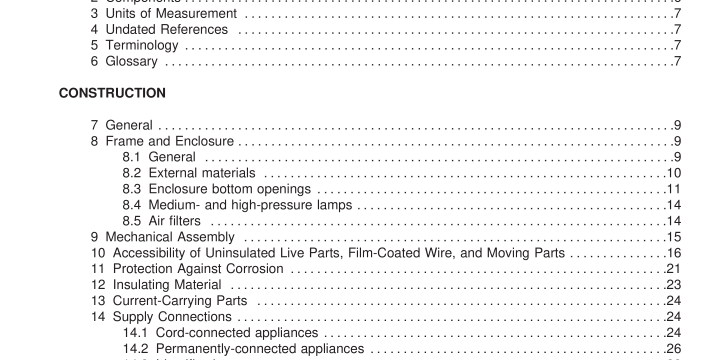UL 38-2008 pdf download.Manual Signaling Boxes for Fire Alarm Systems.
6.6 Strain relief 6.6.1 A strain-relief means shall be provided for the field supply leads and for all internally connected wires subject to movement during installation, operation, or servicing of a signaling box to prevent any mechanical stress from being transmitted to terminals and internal connections. Inward movement of leads provided with a ring-type strain relief or equivalent means shall neither damage internal connections or components nor result in reduction of electrical spacings. 6.6.2 Each lead used for field connections or an internal lead subjected to movement or handling during installation and servicing shall be capable of withstanding for one minute a pull of 1 0 pounds (4.45 N) without any evidence of damage or of transmitting the stress to internal connections. 7 Internal Wiring 7.1 General 7.1 .1 Wiring shall have insulation rated for the potential involved and the temperatures to which it may be subjected. The wiring shall be routed away from moving parts and sharp projections and held in place with clamps, string ties, or the equivalent, unless of sufficient rigidity to retain a shaped form. 7.1 .2 Leads or a cable assembly connected to parts mounted on a hinged cover shall be of sufficient length to permit the full opening of the cover without application of stress to the leads or their connections. The leads shall be secured or equivalently arranged to prevent abrasion of insulation and jamming between parts of the enclosure.
7.1 .3 If the use of a short length of insulated conductor (for example, a short coil lead) is not feasible, electrical insulating tubing may be used. The tubing shall not be subjected to sharp bends, tension, compression, or repeated flexing, and shall not contact sharp edges, projections, or corners. The wall thickness of the tubing shall comply with the requirements for such tubing, except that the wall thickness at any point for polyvinyl chloride tubing of 3/8 inch (9.5 mm) diameter or less, shall not be less than 0.01 7 inch (0.44 mm). For insulating tubing of other types, the wall thickness shall not be less than that required to at least equal the mechanical strength, dielectric properties, heat- and moisture-resistant characteristics, and the like, of polyvinyl chloride tubing having a wall thickness of 0.01 7 inch. 7.1 .4 Internal wiring of circuits that operate at different potentials shall be separated by barriers or shall be segregated, unless the conductors of the circuits of lower voltage are provided with insulation equivalent to that required for the highest voltage involved. Segregation of insulated conductors may be accomplished by clamping, routing, or equivalent means providing permanent separation. 7.1 .5 Stranded conductors clamped under wire-binding screws or similar parts shall have the individual strands soldered together or shall be equivalently arranged.
7.3 Splices 7.3.1 All splices and connections shall be mechanically secured and electrically bonded. 7.3.2 A splice shall be provided with insulation equivalent to that of the wires involved. 7.3.3 A splice shall be located, enclosed, and supported so that it is not subject to damage from flexing, motion, or vibration. 7.4 Barriers 7.4.1 A metal barrier shall have a thickness at least equal to that required by Table 3.2, based on the size of the barrier. A barrier of insulation material shall not be less than 0.028 inch (0.71 mm) thick and shall be of greater thickness if its deformation may be readily accomplished so as to defeat its purpose. Any clearance between the edge of a barrier and a compartment wall shall not be more than 1 /1 6 inch (1 .6 mm). 7.5 Bushings 7.5.1 Where a lead or wire harness passes through an opening in a wall, barrier, or enclosing case, there shall be a metal or insulating-type bushing, or the equivalent, which shall be secured in place, and have a smooth, rounded surface against which the wire may bear. 7.5.2 If the opening is in a phenolic composition or other equivalent nonconducting material or in metal of thickness greater than 0.042 inch (1 .07 mm), a smooth surface having rounded edges is considered to be the equivalent of a bushing. 7.5.3 Ceramic materials and some molded compositions may be used for insulating bushings, but separate bushings of wood and of hot-molded shellac may not be used.UL 38-2008 pdf download.
UL 38-2008 pdf download
